![]()
![]()
![]()
Use LEFT and RIGHT arrow keys to navigate between flashcards;
Use UP and DOWN arrow keys to flip the card;
H to show hint;
A reads text to speech;
167 Cards in this Set
- Front
- Back
|
Define Ventilation
|
Process of the exchange of air between the lungs and the ambient air.
|
|
|
Define Inspiration
|
Drawing air inward to the lungs.
|
|
|
Define expiration
|
The relaxation of the chest wall.
|
|
|
Define diffusion
|
Process of becoming widely spread.
|
|
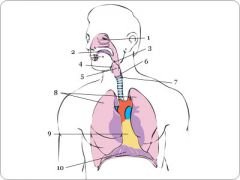
|

|
|
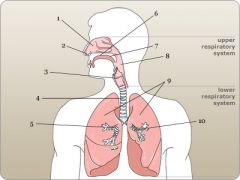
|

|
|
|
nasal septum
|
The partition that divides the two equal cavities of the nose.
|
|
|
perpendicular ethmoid
|
One bone that makes up the nasal septum.
|
|
|
vomer
|
One bone that makes up the nasal septum.
|
|
|
external nares
|
The nostrils.
|
|
|
choanae
|
Internal nares that link the external nares to the nasopharynx.
|
|
|
conchae bones
|
Also called turbinate bones, they create a passageway for the air.
|
|
|
meatus
|
The passage created by the conchae where air flows.
|
|
|
nasopharynx
|
The nasal portion of the pharynx.
|
|
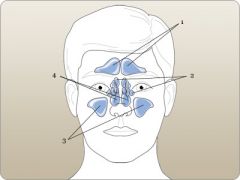
|

|
|

|
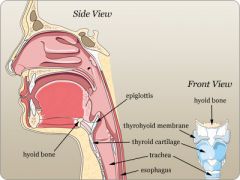
|
|

|
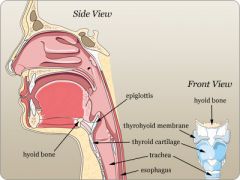
|
|
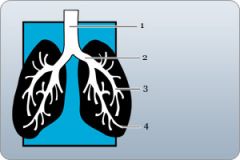
|

|
|
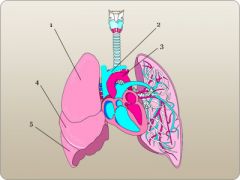
|

|
|
|
septum
|
partition between the two sides of the nasal cavity.
|
|
|
ethmoid
|
perforated like a sieve, such as the ethmoid bone.
|
|
|
vomer
|
Bone of the nasal septum.
|
|
|
choana(e)
|
Link from external nares to nasopharynx.
|
|
|
turbinates
|
Another name for conchae.
|
|
|
meatus
|
Passageway in the body, especially an opening on the surface.
|
|
|
epithelium
|
Lining of small cavities.
|
|
|
epistaxis
|
Nosebleed.
|
|
|
olfaction
|
Sense of smell.
|
|
|
olfactory epithilia
|
Lines the olfactory region of the nasal cavity.
|
|
|
paranasal sinuses
|
Air spaces contained by certain bones of the face.
|
|
|
maxillary sinus
|
One of the paired paranasal sinuses located in the body of the maxilla.
|
|
|
frontal sinus
|
One of the paired irregular shaped paranasal sinuses located in the frontal bone.
|
|
|
sphenoid sinus
|
One of the paired paranasal sinuses in the anterior part of the body of the sphenoid bone.
|
|
|
ethmoidal sinus
|
One of the paranasal sinuses located within the ethmoid bone.
|
|
|
auditory
|
Pertaining to the sense of hearing.
|
|
|
eustachian
|
Tube connecting the nasopharynx to the middle ear.
|
|
|
laryngopharynx
|
Where the respiratory and digestive systems diverge.
|
|
|
thyroid
|
Gland situated in the lower part of the front of the neck.
|
|
|
cricoid
|
Ring-shaped cartilage making up the lower larynx.
|
|
|
arytenoid
|
Vocal cord cartilage.
|
|
|
bifurcates
|
Divided into two branches.
|
|
|
bifurcation
|
Site where a single structure divides into two.
|
|
|
carina
|
Cartilaginous plate of the trachea.
|
|
|
bronchial tree
|
Another name for pulmonary bronchus.
|
|
|
tertiary
|
Third in order.
|
|
|
bronchioles
|
One of the subdivisions of the branched bronchial tree.
|
|
|
alveolar ducts
|
Small passages connecting the respiratory bronchioles and the alveolar sacs.
|
|
|
alveoli
|
Functional units of the respiratory system.
|
|
|
arytenoid
|
Vocal cord cartilage.
|
|
|
arytenoid
|
Vocal cord cartilage.
|
|
|
mediastinal space
|
Space separating the lungs.
|
|
|
bifurcates
|
Divided into two branches.
|
|
|
bifurcates
|
Divided into two branches.
|
|
|
bifurcation
|
Site where a single structure divides into two.
|
|
|
carina
|
Cartilaginous plate of the trachea.
|
|
|
bifurcation
|
Site where a single structure divides into two.
|
|
|
bronchial tree
|
Another name for pulmonary bronchus.
|
|
|
carina
|
Cartilaginous plate of the trachea.
|
|
|
tertiary
|
Third in order.
|
|
|
bronchial tree
|
Another name for pulmonary bronchus.
|
|
|
bronchioles
|
One of the subdivisions of the branched bronchial tree.
|
|
|
tertiary
|
Third in order.
|
|
|
alveolar ducts
|
Small passages connecting the respiratory bronchioles and the alveolar sacs.
|
|
|
bronchioles
|
One of the subdivisions of the branched bronchial tree.
|
|
|
alveolar ducts
|
Small passages connecting the respiratory bronchioles and the alveolar sacs.
|
|
|
alveoli
|
Functional units of the respiratory system.
|
|
|
mediastinal space
|
Space separating the lungs.
|
|
|
alveoli
|
Functional units of the respiratory system.
|
|
|
mediastinal space
|
Space separating the lungs.
|
|
|
mediastinum
|
Mass of tissues and organs separating the two pleural sacs.
|
|
|
lobules
|
Division of lung lobes.
|
|
|
pleura
|
Serous membrane of the thoracic cavity.
|
|
|
visceral
|
Pleura which is adherent to the outer surface of the lung.
|
|
|
parietal
|
Pleura that lines the thoracic wall and diaphragm.
|
|
|
diaphragm
|
Partition that separates the abdominal and thoracic cavities.
|
|
|
pulmonary alveoli
|
Small outpouchings along the walls of the alveolar sacs where gas exchange takes place.
|
|
|
pulmonology
|
Specialty that deals primarily with problems of the respiratory system.
|
|
|
incentive spirometry
|
Measurement of the breathing capacity of the lungs.
|
|
|
chest pain
|
Any discomfort in the thoracic cavity.
|
|
|
clubbing
|
Enlargement of the ends of the fingers and toes with loss of the nailbed angle. This can be an indication of several pulmonary disorders and is usually examined in conjunction with cyanosis and edema.
|
|
|
congestion
|
Excessive or abnormal accumulation of fluid (such as mucus in the sinuses).
|
|
|
cough
|
A sudden, noisy expulsion of air from the lungs. This is a reflex to keep the airway free of foreign matter.
|
|
|
cyanosis
|
Bluish discoloration, particularly of the nailbeds and perioral area. Again, this may be seen in conjunction with clubbing and edema.
|
|
|
dyspnea
|
Difficulty breathing.
|
|
|
hemoptysis
|
Coughing up blood or bloodstained sputum, usually due to bleeding somewhere in the respiratory tract.
|
|
|
hiccup (hiccough)
|
An involuntary spasmodic contraction of the diaphragm that occurs on inspiration and results in a distinctive sound. You may sometimes see this spelled “hiccough.”
|
|
|
malaise
|
A vague feeling of bodily discomfort and fatigue, not necessarily related specifically to respiratory function.
|
|
|
sputum
|
Matter that is ejected from the lungs, bronchi, and trachea through the mouth.
|
|
|
purulent
|
Containing pus.
|
|
|
rales
|
Usually pronounced “rawls” (but sometimes “rails” or “rals”—rhyming with “pals”). These are discontinuous nonmusical sounds heard primarily during inspiration. They are also called crackles.
|
|
|
rhonchi
|
Continuous dry rattling sounds in the throat or bronchial tube due to a partial obstruction.
|
|
|
stridor
|
A musical sound, heard with a stethoscope on inspiration.
|
|
|
tachypnea
|
Shortness of breath. Excessive rapidity of respiration or quick, shallow breathing.
|
|
|
wheezing
|
Whistling or wheezing noises associated with breathing; a telltale symptom of asthma.
|
|
|
thoracentesis
|
The surgical puncture of the chest wall in order to aspirate fluid.
|
|
|
percussion
|
Striking a part with short, sharp blows.
|
|
|
hypoxemia
|
Deficiency of oxygen in the blood.
|
|
|
bronchoscopy
|
Examination of the bronchi with a scope.
|
|
|
auscultation
|
Listening for sounds within the body.
|
|
|
hypoxia
|
Deficiency of oxygen in the blood.
|
|
|
hypercapnia
|
An abundance of carbon dioxide in the blood.
|
|
|
anoxia
|
A total lack of oxygen in the blood.
|
|
|
abscess
|
A localized collection of pus buried in tissues, organs, or confined spaces.
|
|
|
adult respiratory distress syndrome (ARDS)
|
Chronic respiratory failure associated with various acute pulmonary injuries. It is characterized by pulmonary edema, respiratory distress, and hypoxemia. It is sometimes a complication of major surgery and is accompanied by infection.
|
|
|
apnea
|
Cessation of breathing.
|
|
|
asphyxia
|
Suffocation. This can be deliberate and traumatic, occur as a result of some obstruction of the airway, or due to some other cause.
|
|
|
asthma
|
This is a condition that is marked by recurrent attacks of paroxysmal dyspnea and it is manifested by wheezing. It can be due to an allergic reaction, strenuous exercise, irritant particles in the air, psychological stresses, or other factors.
|
|
|
paroxysmal
|
A paroxysm is a sudden recurrence or intensification of symptoms.
|
|
|
atelectasis
|
Incomplete expansion of a lung, a shrunken or airless lung. This can be either acute or chronic and can be complete or partial. This is determined via a chest x-ray.
|
|
|
bronchiectasis
|
An irreversible chronic dilation of the bronchi that is usually accompanied by infection. It is manifested by fetid breath and paroxysmal coughing with the expectoration of mucopurulent matter.
|
|
|
fetid
|
Having a rank or disagreeable smell.
|
|
|
expectoration
|
The act of coughing up and spitting out materials from the lungs, bronchi, and trachea.
|
|
|
bronchitis
|
Inflammation of the mucous membrane lining of the bronchial tubes. Significant contributing factors to this condition are cigarette smoking, pollution, and allergies.
|
|
|
bronchopneumonia
|
An inflammation of the lungs which usually begins in the terminal bronchioles.
|
|
|
bronchiolitis
|
An inflammation of the lungs which usually begins in the terminal bronchioles.
|
|
|
bronchoalveolitis
|
An inflammation of the lungs which usually begins in the terminal bronchioles.
|
|
|
bronchopneumonitis
|
An inflammation of the lungs which usually begins in the terminal bronchioles.
|
|
|
chronic obstructive pulmonary disease (COPD)
|
A generalized term related to persistent airways obstructions. COPD is associated with various combinations of chronic bronchitis, respiratory bronchiolitis, asthma, and/or emphysema. The term "airways obstruction" refers to an increased resistance to airflow during forced expiration.
|
|
|
coccidioidomycosis
|
A fungal disease that infects the respiratory system as a result of the inhalation of spores. Manifested primarily by cold symptoms. Also called "valley fever."
|
|
|
emphysema
|
A pathological accumulation of air in tissues or organs, especially the lungs. In pulmonary emphysema, there is dilatation of the alveoli and destruction of their walls. It is a common cause of disability and eventual death for cigarette smokers.
|
|
|
empyema
|
Accumulation of pus in a cavity of the body. Although there are different types, when the term is used without a qualifier, it refers to thoracic empyema, which is in the pleural space.
|
|
|
epiglottitis
|
Inflammation of the epiglottis.
|
|
|
epistaxis
|
Nosebleed (hemorrhage from the nose).
|
|
|
hemothorax
|
A collection of blood in the pleural cavity. This often results from a blunt or penetrating trauma to the chest wall.
|
|
|
hyaline membrane disease
|
This is a disorder usually affecting premature newborns in which the alveoli are lined by a hyaline material. It usually results in extensive atelectasis and is often fatal.
|
|
|
hyperventilation
|
A state in which there is an increase in the amount of air entering the pulmonary alveoli, which results in a decrease in carbon dioxide tension.
|
|
|
infiltrate
|
Material deposited in organs or cells which are not normal to it, or in excessive quantities. It is also a sign of acute inflammation.
|
|
|
interstitial lung disease
|
Interstitial is a term that means pertaining to or situated between parts or in the interspaces of a tissue. There are several types of interstitial lung disease in which there is an abnormal accumulation of many different cell types in the alveoli and bronchioles, which ultimately leads to progressive destruction of the lung.
|
|
|
laryngitis
|
Inflammation of the larynx. Usually associated with dryness and soreness of the throat, hoarseness, cough, and dysphagia.
|
|
|
papilloma
|
A papilloma is a benign tumor. In the respiratory system, these are common in children, starting at age one, and can grow exuberantly in the larynx. They are viral in origin and cause hoarseness. They can be removed surgically but tend to recur.
|
|
|
pertussis
|
An acute, highly contagious infection of the respiratory tract, most frequently seen in young children and characterized by paroxysmal coughing. Also called "whooping cough."
|
|
|
pleural effusion
|
Excess fluid in the pleural space. The presence of fluid in the pleural space is usually determined by x-ray and almost always requires a thoracentesis.
|
|
|
serous
|
Fluid that is clear and yellow.
|
|
|
sanguineous
|
Bloody or blood-tinged fluid.
|
|
|
serosanguineous
|
Fluid containing both serum and blood.
|
|
|
pleurisy
|
Inflammation of the pleura. It is usually characterized by pain that is worse with breathing and coughing. The onset is usually sudden.
|
|
|
pneumoconiosis
|
A condition characterized by the permanent deposition of substantial amounts of particulate matter into the lungs. It is also called occupational pneumonia.
|
|
|
anthracosis
|
A common type of pneumoconiosis, also called “black lung.”
|
|
|
asbestosis
|
A common type of pneumoconiosis due to the inhalation of asbestos fibers.
|
|
|
berylliosis
|
A common type of pneumoconiosis due to beryllium dust.
|
|
|
silicosis
|
A common type of pneumoconiosis due to sand particles.
|
|
|
pneumonia
|
Also called pneumonitis, this is inflammation of the lung resulting in consolidation, which is defined as a pathologic process where normally aerated lung tissue is converted into a dense, airless mass. There are many kinds of pneumonia caused by a variety of factors, the most common being a type of bacteria. It often results in hospitalization.
|
|
|
pneumonitis
|
Another name for pneumonia. (Pneumonia can also be viral or fungal in nature. A few of the bacterial pathogens are listed below.)
|
|
|
consolidation
|
A pathologic process where normally aerated lung tissue is converted into a dense, airless mass.
|
|
|
Hemophilus influenzae
|
This is the second most common cause of bacterial pneumonia. The most serious strain of this is type b, which is usually called Hib pneumonia.
|
|
|
Klebsiella pneumoniae
|
This is the most frequent of the gram-negative bacilli and it normally affects already compromised lungs, such as with the very young or the very old, hospital or nursing home patients, immuno-compromised hosts, or alcoholics.
|
|
|
Pseudomonas aeruginosa
|
A gram-negative pathogen.
|
|
|
Acinetobacter
|
A gram-negative pathogen.
|
|
|
Legionella pneumophila
|
Also known as Legionnaires' disease, this only accounts for 1% to 8% of pneumonias. It can occur at any age, and early phase symptoms include headache, malaise, fever, myalgia, and a cough which eventually produces mucoid sputum.
|
|
|
Legionnaires' disease
|
Another name for Legionella pneumophila.
|
|
|
Mycoplasma pneumoniae
|
This is the most common pathogen for children and young adults (age 5 to 35 years), but is otherwise quite rare. It has a long incubation period (10–14 days), which accounts for its steady spread. Early symptoms also mimic the flu, malaise, dry cough, and sore throat.
|
|
|
Pneumococcus pneumoniae
|
Pneumococcus pneumoniae is the most common cause for bacterial pneumonia. It usually begins with an upper respiratory infection, including congestion. The onset is often a single shaking chill followed by fever, pain with breathing, cough, dyspnea, and sputum production.
|
|
|
Staphylococcus aureus
|
Staphylococcus aureus accounts for approximately 2% of community-acquired pneumonias. Patients at particular risk are infants, the elderly, hospitalized patients, surgical patients, and patients with immunosuppression. Its symptoms closely mimic those of pneumococcal pneumoniae, although the mortality rate is as high as 30% to 40%.
|
|
|
Streptococcus pneumoniae
|
This has become relatively rare since World War I and is usually a complication of influenza, measles, chickenpox, or pertussis.
|
|
|
pneumothorax
|
Free air in the pleural cavity between the visceral and parietal pleurae. It may occur either spontaneously or because of trauma or pathological process.
|
|
|
rhinitis
|
Inflammation of the mucous membranes of the nose. Often accompanied by rhinorrhea (a runny nose).
|
|
|
sarcoidosis
|
Also called Boeck sarcoid, this is a systemic disease of unknown etiology with the most severe manifestation being granulomatous pneumonitis.
|
|
|
Boeck sarcoid
|
Another name for sarcoidosis.
|
|
|
granulomatous
|
Pertaining to any small nodular aggregation of a certain kind of cells.
|
|
|
sinusitis
|
Inflammation of a sinus. It is usually designated by the name of the sinus that is inflamed (e.g., ethmoid sinusitis).
|
|
|
tonsillitis
|
Inflammation of the tonsils, especially the palatine tonsils.
|
|
|
rhinorrhea
|
Runny nose.
|
|
|
tracheitis
|
Inflammation of the trachea.
|
|
|
tuberculosis
|
A chronic, recurrent infection most common in the lungs, although any organ may be affected.
|
|
|
Mycobacterium tuberculosis
|
The gram-positive bacterium that causes tuberculosis.
|
|
|
upper respiratory infection (URI)
|
The common cold. An acute, usually afebrile viral infection of the respiratory tract with inflammation in any or all of the airways, including the nose, paranasal sinuses, throat, larynx, and often the trachea and bronchi. You are probably familiar with the symptoms.
|
|
|
Wegener's granulomatosis
|
An uncommon disease that usually begins as a localized granulomatous inflammation of the upper and/or lower respiratory tract mucosa.
|

